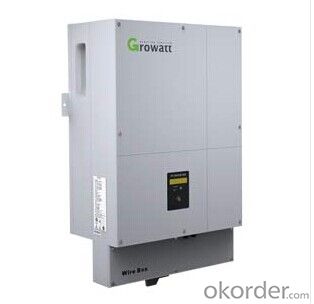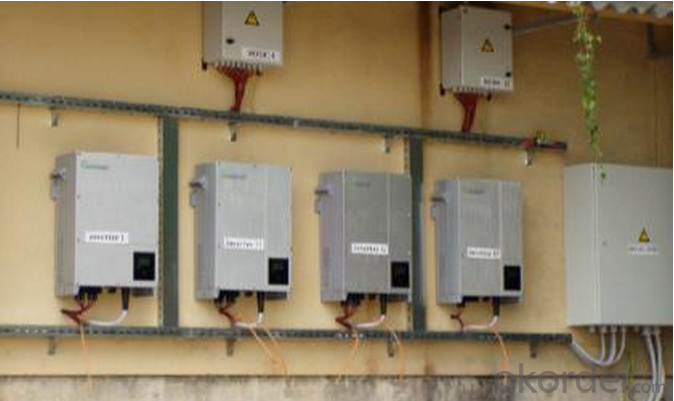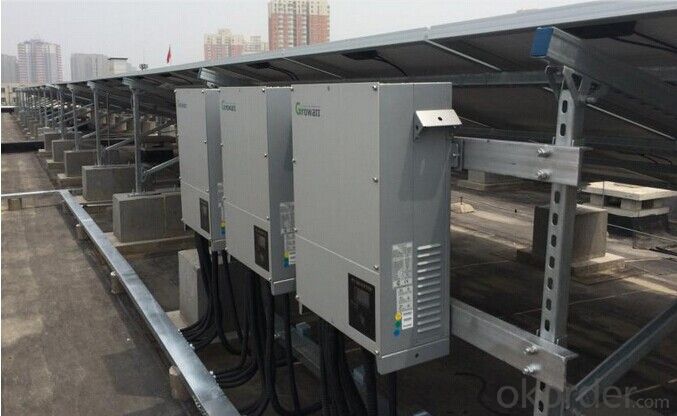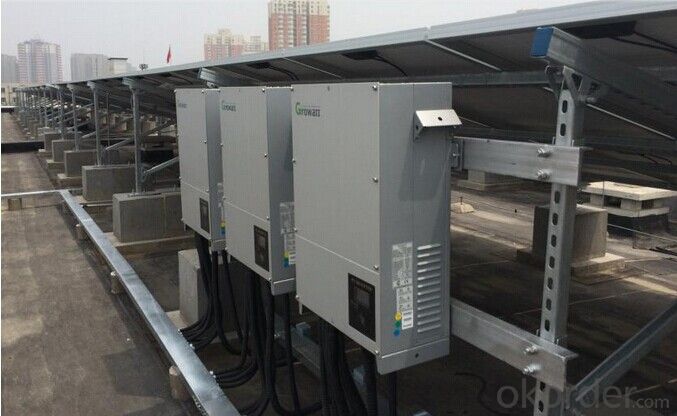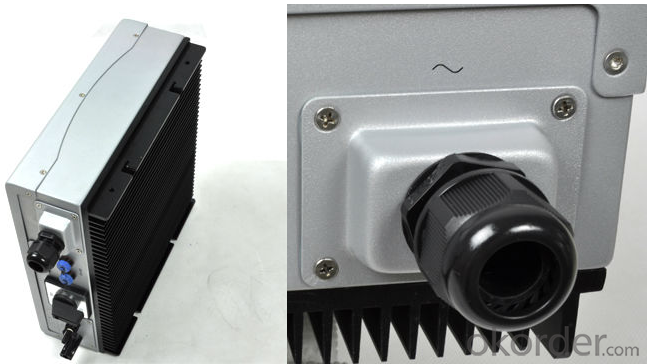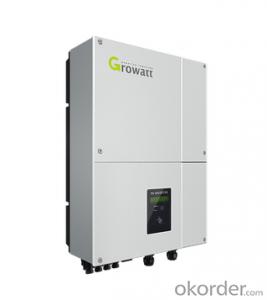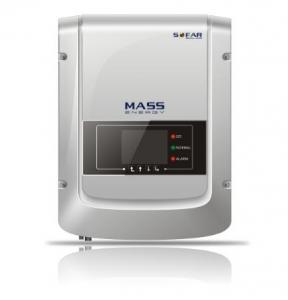Solar Inverter Company Grid Tied Solar Inverter 8000W-11000W Max 8300W TUV/UL/CSA/FCC
- Loading Port:
- Shekou
- Payment Terms:
- TT or LC
- Min Order Qty:
- 10 pc
- Supply Capability:
- 100000 pc/month
OKorder Service Pledge
OKorder Financial Service
You Might Also Like
Grid Tied Solar inverter 8000-11000kw
High efficiency of 97.8% delivery more energy
Integrated DC disconnect switch
Consistent and stable performance across entire input voltage and output power voltage
Intelligent temperature management
Power balancer for three-phase grid connection
Bluetooth/ RF technology/ Wi-Fi
Sound control, easy installation maintenance procedure
Newest generation IGBTs and advanced MPPT algorithms
8000TL-US | 9000TL-US | 10000TL-US | 11000TL-US | |
| Inputdata | ||||
| Max. DC power | 8300W | 9300W | 10350W | 11400W |
| Max. DC voltage | 600V | 600V | 600V | 600V |
| Start Voltage | 360V | 360V | 360V | 360V |
| DC nominal voltage | 345V@ 208VAC 379V@ 240VAC | 345V@ 208VAC 379V@ 240VAC | 345V@ 208VAC 379V@ 240VAC | 379V |
| PV voltage range | 300-600V@208V 345-600V@240V | 300-600V@208V 345-600V@240V | 300-600V@208V 345-600V@240V | 345-600V@208V 345-600V@240V |
| MPP voltage range(full load) | 300-480V@208V 345-480V@240V | 300-480V@208V 345-480V@240V | 300-480V@208V 345-480V@240V | 300-480V@208V 345-480V@240V |
| Max. input current/per string | 30A/16A | 33A/16A | 36A/16A | 35A/16A |
| Number of MPP trackers/ strings per MPP tracker | 1/4 | 1/4 | 1/4 | 1/4 |
| Efficiency | ||||
Max.efficiency | 97.8% | 97.8% | 97.8% | 97.5% |
| Rated AC output power | 8000W | 9000W | 10000W | 11000W |
| AC nominal voltage; range | 208V/240V;183-229V@208V,211-264V@240V | |||
| Max. output current | 44A@208V 38A@240V | 44A@208V 38A@240V | 44A@208V 38A@240V | 38A@240V |
| AC grid frequency; range | 60Hz; 59.3-60.5Hz | 60Hz; 59.3-60.5Hz | 60Hz; 59.3-60.5Hz | 60Hz; 59.3-60.5Hz |
| Power factor | 1 | 1 | 1 | 1 |
| THDI | <3% | <3% | <3% | <3% |
| Grid connection type | Two phase | Two phase | Two phase | Two phase |
| Features | ||||
Display Warranty: 10years/15years | LCD opt/opt/opt | LCD opt/opt/opt yes/opt | LCD yes/yes/ opt/opt/opt yes/opt | LCD opt/opt/opt yes/opt |
| Generaldata | ||||
Dimensions(W/H/D) in mm Weight Operating temperature range Noise emission(typical) Self-Consumption (night) Topology Cooling concept Environmental Protection rating Altitude Relative Humidity | 400/743/222 40KG -25℃ ... +60℃ <46db(a)< p=""> <0.5W Transformerless Smart cooling NEMA 3R 2000m withoutderating 0~100% | 400/743/222 40KG -25℃ ... +60℃ <46db(a)< p=""> <0.5W Transformerless Smart cooling NEMA 3R 2000m withoutderating 0~100% | 400/743/222 40KG -25℃ ... +60℃ <46db(a)< p=""> <0.5W Transformerless Smart cooling NEMA 3R 2000m withoutderating 0~100% | 400/743/222 40KG -25℃ ... +60℃ <46db(a)< p=""> <0.5W Transformerless Smart cooling NEMA 3R 2000m withoutderating 0~100% |
| Certificates and ApprovalsUL 1741, UL 1998, IEEE 1547, FCC part 15(Class B), CSA C22.2 No. 107.1 |
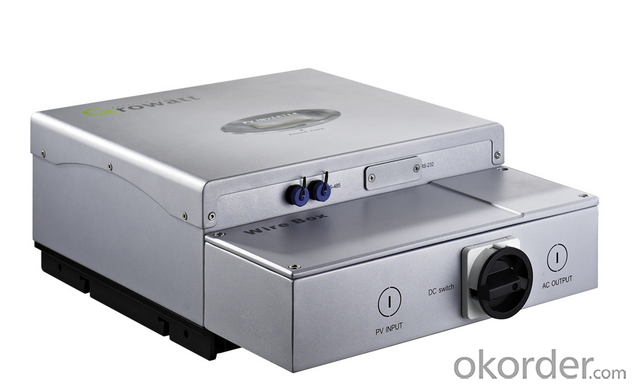
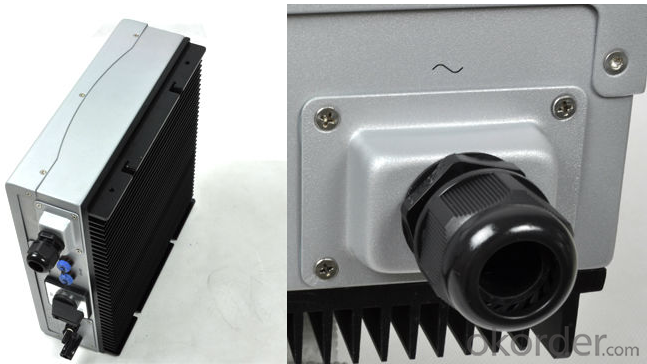
- Q: Can a solar inverter be used in regions with high levels of lightning activity?
- Yes, a solar inverter can be used in regions with high levels of lightning activity. However, it is important to ensure that the solar inverter is properly installed and equipped with surge protection devices to mitigate the risks associated with lightning strikes. Additionally, regular maintenance and inspections should be carried out to ensure the safety and functionality of the solar inverter in such regions.
- Q: PV grid-connected inverter can directly load it?
- Grid-connected inverter is usually equipped with island protection function, can only receive the power grid, if the load directly, the output is disconnected.
- Q: How does a solar inverter handle voltage phase imbalance in the grid?
- A solar inverter handles voltage phase imbalance in the grid by continuously monitoring the grid's voltage and frequency. If it detects any phase imbalance, it adjusts its output to balance the voltage across all phases. This ensures that the power generated by the solar panels is synchronized with the grid and prevents any issues that may arise due to phase imbalances, such as equipment damage or power quality issues.
- Q: How does a solar inverter handle voltage regulation during load changes?
- A solar inverter handles voltage regulation during load changes by continuously monitoring the output voltage and adjusting its operation accordingly. When there is a sudden increase or decrease in load, the inverter's control system quickly responds by either increasing or decreasing the amount of power it draws from the solar panels. This ensures that the voltage remains stable and within the desired range, minimizing the impact of load changes on the system.
- Q: Can a solar inverter be used with different types of monitoring systems?
- Yes, a solar inverter can be used with different types of monitoring systems. Most modern solar inverters are designed to be compatible with various monitoring systems, allowing users to choose the system that best suits their needs and preferences. This flexibility enables the integration of different monitoring technologies, such as Wi-Fi, Ethernet, or cellular connectivity, making it easier to monitor and manage solar energy production.
- Q: How does a solar inverter handle voltage and frequency variations caused by voltage sags and swells?
- A solar inverter handles voltage and frequency variations caused by voltage sags and swells by monitoring the input voltage and frequency constantly. When it detects a variation, it employs internal control mechanisms to adjust the output voltage and frequency accordingly. This ensures that the solar inverter delivers stable and reliable power to the connected load, even during voltage fluctuations.
- Q: How does a solar inverter handle frequency variations in the grid?
- A solar inverter handles frequency variations in the grid by continuously monitoring the frequency and adjusting its own output accordingly. When the grid frequency increases, the inverter reduces its output frequency to match, and vice versa. This helps maintain a stable and synchronized connection to the grid, ensuring efficient power transfer and protecting both the inverter and the grid from potential damage or instability.
- Q: Can a solar inverter be used with a solar-powered water desalination system?
- Yes, a solar inverter can be used with a solar-powered water desalination system. A solar inverter is responsible for converting the direct current (DC) generated by solar panels into alternating current (AC) that can be used to power various electrical devices, including a water desalination system. By connecting the solar panels to the solar inverter and then to the water desalination system, the renewable energy produced by the sun can be harnessed and utilized efficiently for the desalination process.
- Q: Can a solar inverter be used in a smart grid system?
- Yes, a solar inverter can be used in a smart grid system. A solar inverter is responsible for converting the direct current (DC) generated by solar panels into alternating current (AC) that can be used to power homes and businesses. In a smart grid system, the solar inverter can play a crucial role in integrating solar energy into the grid, enabling bi-directional energy flow, and facilitating real-time communication and control between the solar system, grid operators, and consumers. This allows for efficient energy management, improved grid stability, and optimization of renewable energy utilization within the smart grid network.
- Q: What is the role of a cooling system in a solar inverter?
- The role of a cooling system in a solar inverter is to regulate and dissipate heat generated during the conversion of DC power from solar panels to AC power for use in homes or businesses. By maintaining optimal operating temperatures, the cooling system ensures the inverter's components do not overheat, which could lead to reduced efficiency, performance degradation, or even system failure.
Send your message to us
Solar Inverter Company Grid Tied Solar Inverter 8000W-11000W Max 8300W TUV/UL/CSA/FCC
- Loading Port:
- Shekou
- Payment Terms:
- TT or LC
- Min Order Qty:
- 10 pc
- Supply Capability:
- 100000 pc/month
OKorder Service Pledge
OKorder Financial Service
Similar products
Hot products
Hot Searches
Related keywords





